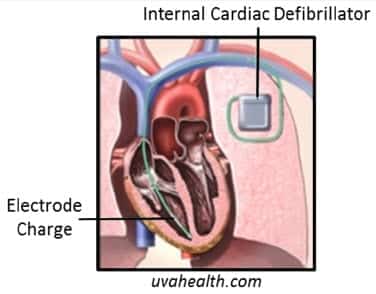Diagnosis
Life-threatening arrhythmias or severe congenital heart disease that can lead to sudden cardiac arrest. These arrhythmias are caused by faulty electrical wiring in the heart. Arrhythmias can cause the heart to beat too fast, too slow, or just beat irregularly. If the heart is not efficiently pumping blood, vital organs like the brain will not receive enough oxygen to survive.
Medical device treatment
An internal cardiac defibrillator or pacemaker can help to control the heart rate and prevent a sudden cardiac arrest from occurring.
How it works

An internal cardiac defibrillator works by sensing irregularities in the heart beat and then sending small electrical signals to the heart to correct the beat. If small electrical signals are not enough, it sends a larger signal to the heart to jumpstart it, like the defibrillators used in hospitals. The device has wires that are inserted into one or more chambers of the heart and is connected to a small box that is located in the abdomen or chest. The box holds a battery, a computer, and a pulse generator. The computer senses an irregular heart beat and tells the pulse generator to send out small electrical signals. A pacemaker works in a similar way to the internal cardiac defibrillator. It can help keep the heart beating at a regular pace by providing small electrical signals to the heart when it is needed. The pacemaker does not have the ability to produce larger electrical signals to the heart in the occurrence of a sudden cardiac arrest.